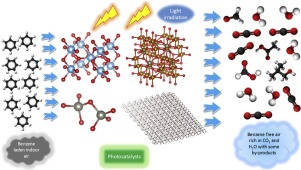Journal of Photochemistry and Photobiology C: Photochemistry Reviews ( IF 12.8 ) Pub Date : 2019-08-31 , DOI: 10.1016/j.jphotochemrev.2019.08.003 Kumar Vikrant , Chang Min Park , Ki-Hyun Kim , Sandeep Kumar , Eui-Chan Jeon

|
The photocatalytic technique is a promising alternative option for the treatment of volatile organic compounds (VOCs) to replace conventional methods. The primary feature of photocatalysis is the generation of environmentally benign end products (water and carbon dioxide). Titanium dioxide (TiO2) has been the most frequently used photocatalyst, and the advent of TiO2-based composites and other novel materials has expanded the photocatalytic domain in terms of efficiency and visible-light operation. This review assesses the performance of recently developed photocatalysts in removal of gaseous benzene (as a model VOC). The applied photocatalytic systems were classified by mode of operation, i.e., a continuous or batch system. The results of diverse studies were compared and evaluated in terms of key performance metrics (e.g., space-time and quantum yield values) to learn more about the influence of inherent properties (e.g., surface chemistry, functionalities, and structure) and operational conditions (e.g., humidity and processing time) on the destruction of VOCs. Further, attempts are made to compare the performance of continuous-mode photocatalytic systems against an adsorption system in terms of space velocity. In addition, photothermal catalysis was discussed as a hybrid technology for future applications. The article also highlights the present obstacles and possible opportunities for the application of photocatalytic systems toward air quality management.
中文翻译:

破坏气态苯的基于光催化剂的平台的最新进展:不同模式的光催化操作和针对吸附技术的性能评估
光催化技术是用于处理挥发性有机化合物(VOC)的有前途的替代选择,可替代传统方法。光催化的主要特征是产生对环境无害的最终产品(水和二氧化碳)。二氧化钛(TiO 2)是最常用的光催化剂,也是TiO 2的出现基复合材料和其他新型材料在效率和可见光操作方面扩大了光催化领域。这篇评论评估了最近开发的光催化剂在去除气态苯(作为VOC模型)方面的性能。所应用的光催化系统按操作模式进行分类,即连续或间歇系统。根据关键性能指标(例如时空和量子产率值)对各种研究的结果进行了比较和评估,以了解有关固有特性(例如表面化学,功能和结构)和操作条件的影响的更多信息( (例如湿度和处理时间)破坏VOC。进一步,试图从空速方面比较连续模式光催化系统与吸附系统的性能。此外,讨论了光热催化作为一种混合技术,可用于未来的应用。本文还重点介绍了将光催化系统应用于空气质量管理的当前障碍和可能的机会。











































 京公网安备 11010802027423号
京公网安备 11010802027423号